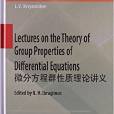《微分方程群性質理論講義》是2013年4月高等教育出版社出版的圖書,作者是奧夫斯亞尼科夫。
基本介紹
- 書名:微分方程群性質理論講義
- 作者:奧夫斯亞尼科夫
- ISBN:9787040369441
- 頁數:141
- 定價:49.00元
- 出版社:高等教育出版社
- 出版時間:2013-4
內容簡介,圖書目錄,
內容簡介
《微分方程群性質理論講義(英文)》提供了確定和利用微分方程對稱性的李群方法簡明和清晰的介紹,並提供了在氣體動力學和其他非線性模型中的大量套用,以及《微分方程群性質理論講義(英文)》作者在這個經典領域的卓越貢獻。《微分方程群性質理論講義(英文)》中還包含在其他現代書籍中不曾涉及的一些非常有用的材料,例如:Ovsyannikov教授發展的部分不變解理論,該理論提供了求解非線性微分方程和研究複雜數學模型強有力的工具。
圖書目錄
Editor's preface
Preface
1 One-parameter continuous transformation groups admitted by differential equations
1.1 One-parameter continuous transformation group
1.1.1 Definition
1.1.2 Canonical parameter
1.1.3 Examples
1.1.4 Auxiliary functions of groups
1.2 Infinitesimal operator of the group
1.2.1 Definition and examples
1.2.2 Transformation of functions
1.2.3 Change of coordinates
1.3 Invariants and invariant manifolds
1.3.1 Invariants
1.3.2 Invariant manifolds
1.3.3 Invariance of regularly defined manifolds
1.4 Theory of prolongation
1.4.1 Prolongation of the space
1.4.2 Prolonged group
1.4.3 First prolongation of the group operator
1.4.4 Second prolongation of the group operator
1.4.5 Properties of prolongations of operators
1.5 Groups admitted by differentialequations
1.5.1 Determining equations
1.5.2 First-order ordinary differential equations
1.5.3 Second-orderordinarydifferentialequations
1.5.4 Heat equation
1.5.5 Gasdynamic equations
1.6 Lie algebra of operators
1.6.1 Commutator.Definition of a Lie algebra
1.6.2 Properties of commutator
1.6.3 Lie algebra of admitted operators
2 Lie algebras and local Lie groups
2.1 Lie algebra
2.1.1 Definition and examples
2.1.2 Subalgebra and ideal
2.1.3 Structure of finite-dimensionalLie algebras
2.2 Adjoint algebra
2.2.1 Inner derivation
2.2.2Adjoint algebra
2.2.3 Inner automorphisms of a Lie algebra.
2.3 Local Lie group
2.3.1 Coordinates in a group
2.3.2 Subgroups
2.3.3 Canonical coordinates of the first kind
2.3.4 First fundamental theorem of Lie
2.3.5 Second fundamental theorem of Lie
2.3.6 Properties ofcanonicalcoordinate systems of the first kind
2.3.7 Third fundamental theorem of Lie
2.3.8 Lie algebra of a local Lie group
2.4 Subgroup, normal subgroup and factor group
2.4.1 Lemma on commutator
2.4.2 Subgroup
2.4.2 Subgroup
2.4.3 Normal subgroup
2.4.4 Factor grop
2.5 Inner automorphisms of a group and of its Lie algebra
2.5.1 Inner automorphism.
2.5.2 Lie algebra of GA and adjoint algebra of Lr
2.6 Local Lie group of transformations
2.6.1 Introduction
2.6.2 Lie's first theorem.
2.6.3 Lie's second theorem
2.6.4 Canonical coordinates of the second kind
3 Group invariant solutions of differential equations
3.1 Invariants of the group GNr
3.1.1 Invariance criterion
3.1.2 Functional independence
3.1.3 Linearly unconnected operators
3.1.4 Integration of jacobian systems
3.1.5 Computation ofinvariance
3.2 Invariant manifolds
3.2.1 Invariant manifolds criterion
3.2.2 Induced group and its Lie algebra
3.2.3 Theorem on representation of nonsingular invariant manifolds
3.2.4 Differential invariant manifolds
3.3 Invariant solutions of differential equations
3.3.1 Definition of invariant solutions
3.3.2 The system (S/H)
3.3.3 Examples from one-dimensionalgas dynamics
3.3.4 Self-similar solutions
3.4 Classification of invariant solutions
3.4.1 Invariant solutions for similar subalgebras
3.4.2 Classes of similar subalgebras
3.5 Partially invariant solutions
3.5.1 Partially invariant manifolds
3.5.2 Defect of invariance
3.5.3 Construction of partially invariant solutions
3.6 Reduction of partially invariant solutions
3.6.1 Statement of the reduction problem
3.6.2 Two auxiliary lemmas
3.6.3 Theorem on reduction
3.7 Some problems
Preface
1 One-parameter continuous transformation groups admitted by differential equations
1.1 One-parameter continuous transformation group
1.1.1 Definition
1.1.2 Canonical parameter
1.1.3 Examples
1.1.4 Auxiliary functions of groups
1.2 Infinitesimal operator of the group
1.2.1 Definition and examples
1.2.2 Transformation of functions
1.2.3 Change of coordinates
1.3 Invariants and invariant manifolds
1.3.1 Invariants
1.3.2 Invariant manifolds
1.3.3 Invariance of regularly defined manifolds
1.4 Theory of prolongation
1.4.1 Prolongation of the space
1.4.2 Prolonged group
1.4.3 First prolongation of the group operator
1.4.4 Second prolongation of the group operator
1.4.5 Properties of prolongations of operators
1.5 Groups admitted by differentialequations
1.5.1 Determining equations
1.5.2 First-order ordinary differential equations
1.5.3 Second-orderordinarydifferentialequations
1.5.4 Heat equation
1.5.5 Gasdynamic equations
1.6 Lie algebra of operators
1.6.1 Commutator.Definition of a Lie algebra
1.6.2 Properties of commutator
1.6.3 Lie algebra of admitted operators
2 Lie algebras and local Lie groups
2.1 Lie algebra
2.1.1 Definition and examples
2.1.2 Subalgebra and ideal
2.1.3 Structure of finite-dimensionalLie algebras
2.2 Adjoint algebra
2.2.1 Inner derivation
2.2.2Adjoint algebra
2.2.3 Inner automorphisms of a Lie algebra.
2.3 Local Lie group
2.3.1 Coordinates in a group
2.3.2 Subgroups
2.3.3 Canonical coordinates of the first kind
2.3.4 First fundamental theorem of Lie
2.3.5 Second fundamental theorem of Lie
2.3.6 Properties ofcanonicalcoordinate systems of the first kind
2.3.7 Third fundamental theorem of Lie
2.3.8 Lie algebra of a local Lie group
2.4 Subgroup, normal subgroup and factor group
2.4.1 Lemma on commutator
2.4.2 Subgroup
2.4.2 Subgroup
2.4.3 Normal subgroup
2.4.4 Factor grop
2.5 Inner automorphisms of a group and of its Lie algebra
2.5.1 Inner automorphism.
2.5.2 Lie algebra of GA and adjoint algebra of Lr
2.6 Local Lie group of transformations
2.6.1 Introduction
2.6.2 Lie's first theorem.
2.6.3 Lie's second theorem
2.6.4 Canonical coordinates of the second kind
3 Group invariant solutions of differential equations
3.1 Invariants of the group GNr
3.1.1 Invariance criterion
3.1.2 Functional independence
3.1.3 Linearly unconnected operators
3.1.4 Integration of jacobian systems
3.1.5 Computation ofinvariance
3.2 Invariant manifolds
3.2.1 Invariant manifolds criterion
3.2.2 Induced group and its Lie algebra
3.2.3 Theorem on representation of nonsingular invariant manifolds
3.2.4 Differential invariant manifolds
3.3 Invariant solutions of differential equations
3.3.1 Definition of invariant solutions
3.3.2 The system (S/H)
3.3.3 Examples from one-dimensionalgas dynamics
3.3.4 Self-similar solutions
3.4 Classification of invariant solutions
3.4.1 Invariant solutions for similar subalgebras
3.4.2 Classes of similar subalgebras
3.5 Partially invariant solutions
3.5.1 Partially invariant manifolds
3.5.2 Defect of invariance
3.5.3 Construction of partially invariant solutions
3.6 Reduction of partially invariant solutions
3.6.1 Statement of the reduction problem
3.6.2 Two auxiliary lemmas
3.6.3 Theorem on reduction
3.7 Some problems

